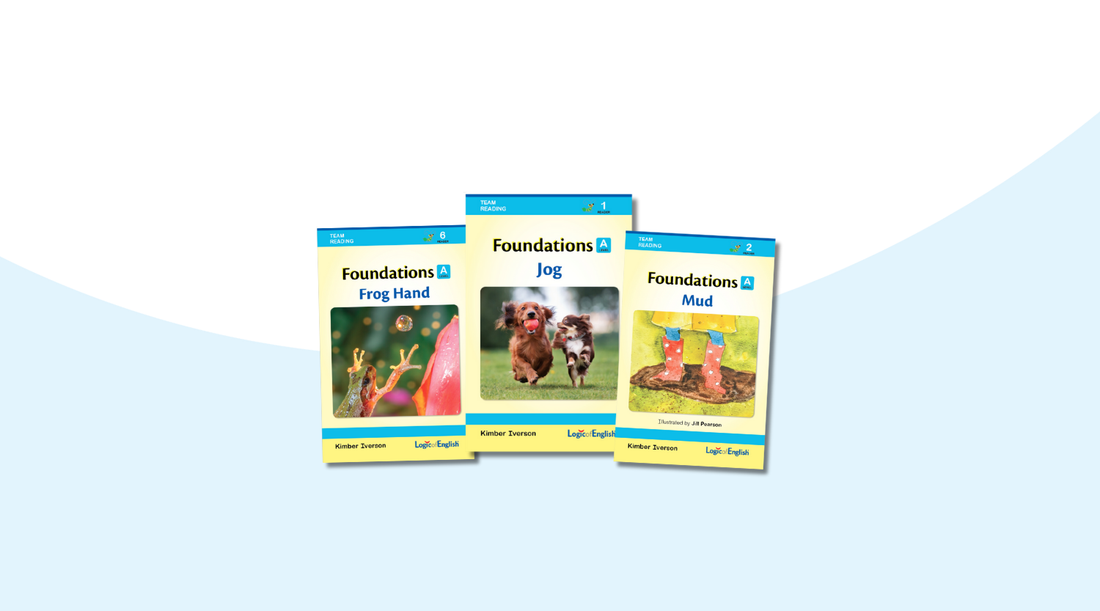All About Our New Foundations A Readers

We are happy to announce a new set of ten Foundations A Readers is now available! Like all Logic of English controlled texts, there is no reliance on sight words or patterns for beginning readers. Instead, these texts give students a chance to apply the phonograms they have learned to decode the text and strengthen the pathways they need in the brain to become strong readers. Here is everything you need to know about this new reader set!
Where do they fall in the curriculum, and how do I use them with my student(s)?
The new readers, written by Kimber Iverson, will provide students with more decoding practice with different texts. Emerging readers will have the opportunity to hold a book in their hands and feel successful as they are only asked to decode concepts they have been explicitly taught in Foundations A. Students will engage in fun, new books with charming illustrations by Jill Pearson and some books filled with fun, humorous, or fascinating photography.
We recommend using the readers with particular lessons in the curriculum’s scope and sequence to provide students with more practice with concepts they have already been taught. To inspire the joy of reading and limit frustration, we strive to never ask students to read anything they have not explicitly been given the tools to decode.
Because these readers are new, they are not yet included in the Foundations A Teacher’s Manual. Use this guide to incorporate them into the end of the following Foundations A lessons:
- Reader 1: Jog - Lesson 26
- Reader 2: Mud - Lesson 27
- Reader 3: Ten Pops - Lesson 29
- Reader 4: Gum Plops - Lesson 31
- Reader 5: Pink Skunk - Lesson 33
- Reader 6: Frog Hand - Lesson 35
- Reader 7: Squid Hid - Lesson 36
- Reader 8: Fox in Tux - Lesson 37
- Reader 9: Bit Bit Big - Lesson 38
- Reader 10: Zip Zap Bug - Lesson 40
The Foundations A Online Planning Guide also includes the new Foundations A Readers placement.
How do the new readers differ from the current readers?
The new topics and stories will engage students in their first solo reading experiences as well as provide opportunities for decoding words and expanding language comprehension through a new Team Reading style of texts. In these texts, beginning readers team up with a more experienced reader to participate in reading texts that have words, phrases, and sentences that may not be decodable for the beginning reader at this point in the curriculum.

Reading One-On-One With a Student
If working one-on-one with a student, the adult or more experienced reader will read the majority of the text, and the student will read the word or phrase in the large bold font. This will allow students to engage with texts they may not be able to completely decode themselves at this point and will work on fundamental skills such as the direction of reading and writing, making predictions, etc. The one-on-one setting could be a student with a teacher, tutor, parent, older sibling, older student, friend, more experienced peer, etc.
Reading in Small Groups
If working with students in a small group, the teacher could read most of the text, and the students could read the student font in chorus or take turns reading the student parts. Having students chorus read to build confidence the first time through and then having them take turns for a second read-through is a great way to work on reading fluency.
Reading in Large Groups
If students are reading in a large group along with a teacher as their experienced reader, the teacher could pause while students chorus read or have students pair up and take turns reading the student text to a partner. The teacher could even go around the room allowing each student to take a turn reading the student text as they come to it.
Sparking Curiosity and Igniting a Joy of Reading
No matter how you choose to use this fun, new style of controlled texts, students will benefit from the interaction with new language and topics! A great advantage of the team readers is being able to engage in discussion with the beginning readers about the topics of the reader. With fiction books, students can make predictions about what is going to happen, while a nonfiction reader, like Frog Hand, takes a look at different things in nature with a zoomed-in photo, and students get to guess what it is when the photo zooms out on the next page. Asking students what they think it will be is a wonderful way to spark curiosity and exercise skills in analysis.

Once they reach lesson 25 of Foundations A, these ten new readers, plus the readers students assemble in the workbook, allow students to have a controlled text in every lesson. We hope you enjoy them!
Foundations A Readers are now included in the Foundations A & Core Materials Bundle and the Foundations A Bundle. They can also be purchased separately in print or PDF.

